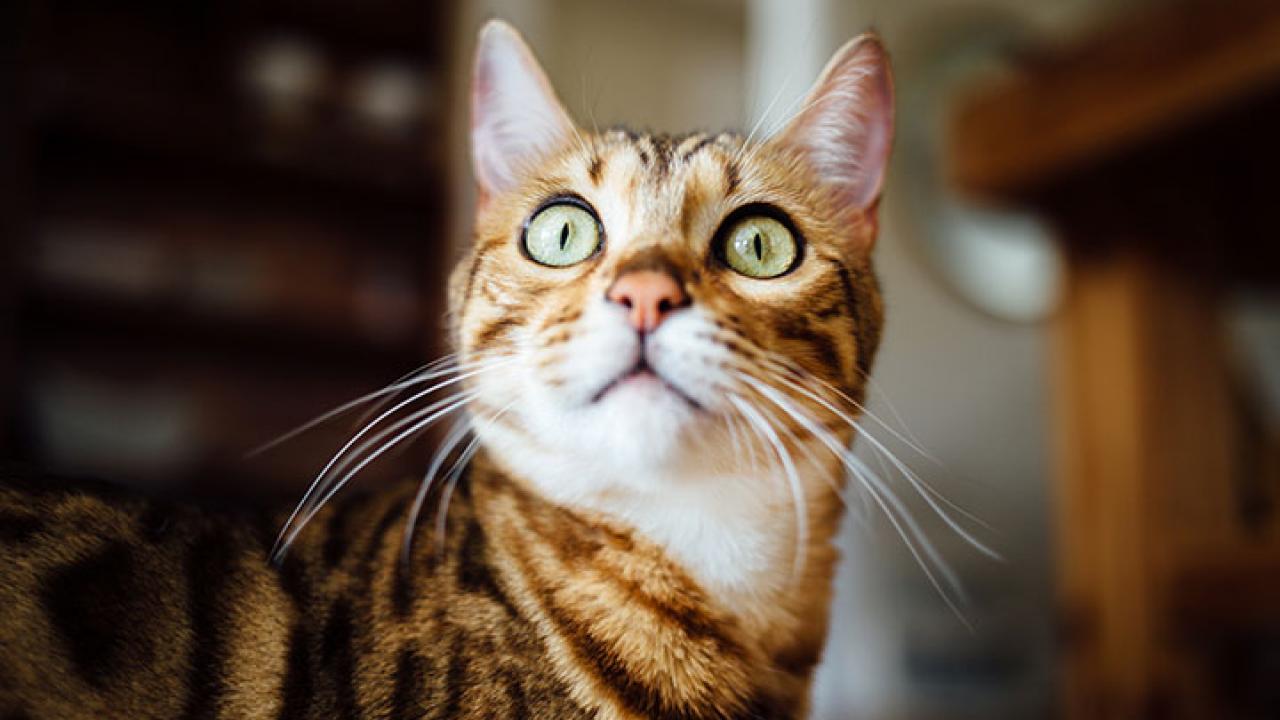
Orbital Disease
Orbital Disease
How we can help
Call 530-752-1393 to schedule an appointment with the Ophthalmology Service.
The orbit is the bony "socket" that contains the eyeball and associated structures like the lacrimal (tear producing) gland, nerves, blood vessels, and extraocular muscles. It is composed of a large number of bones with small holes (foramina) for the passage of nerves and blood vessels. The orbit is an essential structure for protection of the sensitive structures required for normal vision, especially the eye itself. It also acts as the anchor point for the extraocular muscles that are responsible for eye movement. Orbital disease is a general term used to describe dysfunction of any part of the bony orbit or its soft tissue contents. The ophthalmologists at the UC Davis veterinary hospital diagnose and treat orbital disease in all species. Although each species has some important anatomic variation in the composition of their orbit and tends to be prone to different diseases, some general comments can be made regarding orbital disease.
Clinical Signs
Occasionally orbital disease involves the wasting or atrophy of orbital structures. However, far more commonly orbital disease reflects the presence of a mass within the orbital space. In these cases, clinical signs reflect the fact that the bony orbit cannot expand to accommodate swollen tissues. Therefore the eye protrudes or becomes exophthalmic. Initially this can be very subtle and requires close examination by your veterinarian or a veterinary ophthalmologist. As the disease becomes more advanced, exophthalmos becomes more obvious and is associated with secondary problems such as difficulty closing the eyelids (lagophthalmos), and subsequent drying, inflammation, and ulceration of the cornea and/or conjunctiva. Involvement of the nerves behind the eye may reduce vision, cause the eyeball to be misdirected (strabismus), alter pupil size or response to light, or reduce the ability to blink. Because of the close proximity of the orbit with the nasal and oral cavities, and the brain, occasionally orbital disease can also affect these tissues. In these cases, any combination of sneezing, difficulty breathing, difficulty opening the jaw, nasal discharge, or central (brain) neurological signs such as seizures or behavioral changes may be seen. In all cases of orbital disease, one or both orbits may be involved.
Diagnosis
Once the existence of orbital disease has been confirmed, further diagnosis usually involves answering three questions:
- Are structures other than the orbit involved?
This usually involves a thorough general physical examination, with emphasis on the eyes, nose, and mouth. A thorough neurological examination emphasizing those nerves involved in normal ocular function may also be necessary. Because neoplasia (cancer) can cause orbital disease and because later steps in the diagnostic approach may require general anesthesia, your veterinarian may suggest some preliminary blood tests and a chest radiograph at this stage. - Where is the orbital mass?
Although the extent of exophthalmos provides some clues as to the size and position of the orbital mass, an accurate assessment of where and how large the mass is requires advanced imaging techniques. Depending on the clinical exam findings, your veterinarian may recommend a combination of ultrasonography, computed tomography (CT scanning) magnetic resonance imaging (MRI), or radiographic examination of the eye, orbit, and surrounding tissues. UC Davis offers all these techniques from a highly skilled group of radiographers and radiologists who conduct and interpret these tests in collaboration with the veterinary ophthalmologist. - What is the orbital mass?
The final step in the diagnosis of orbital disease is to assess the composition of the mass. This can differ widely and each type of disease has a different treatment. In some cases, the treatment for one disease may make another disease worse, therefore this is a critical phase of the diagnosis. This requires the collection of a small sample of the tissue for microscopic diagnosis by a board certified veterinary pathologist. Again, UC Davis is fortunate to have such specialists on its faculty. The biopsy samples are usually collected under general anesthesia and can be done with a needle or through a very small incision.
Treatment
Treatment of orbital disease may be surgical or medical depending on the diagnosis. Some orbital disease, particularly that due to infection or immune-mediated inflammation may be treated with orally administered drugs. In other cases, particularly neoplasia (cancer) surgical removal may be required. In some cases it may be possible to remove the mass while retaining a normally functioning eye. In more advanced or malignant neoplasia, chemotherapy, radiation therapy, or surgical removal of the eye along with the tumor may be necessary.
What to look for
As with most diseases, early diagnosis and treatment of orbital disease is likely to minimize discomfort and provide the best prognosis. Watch for early signs such as altered appearance of your pet's eye, especially being able to see more of the whites (sclera) of the eye; difficulty seeing, blinking, or moving the eye; or altered pupil size or direction of gaze. If you see any of these conditions, please call your local veterinarian. He or she will want to examine your pet and may run some of the initial tests described above. Ultimately, you may be referred to a veterinary ophthalmologist. In this case, the ophthalmologists UC Davis, along with the associated specialties of anesthesia, radiology, and pathology will be happy to provide you, your pet, and your local veterinarian with specialist assistance.
*This article may not be reproduced without the written consent of the UC Davis School of Veterinary Medicine.
